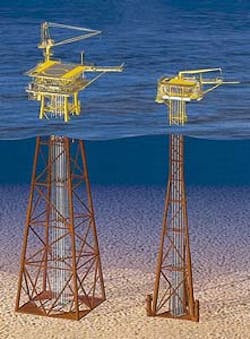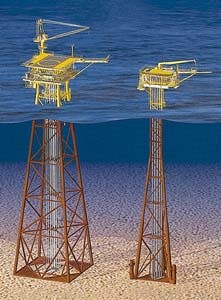Gulf of Thailand E&D action at brisk pace
Exploration and development continues to advance off Thailand.
Artist's rendering shows Unocal Thailand Ltd.'s new tripod wellhead platform, at right, in contrast with larger 4-pile structures that have been used in Gulf of Thailand development. Rendering courtesy of Unocal Thailand.Unocal Thailand Ltd. has begun installing the first of its fully automated, proprietary tripod platforms in Pladang and Funan fields in the Gulf of Thailand (OGJ, Jan. 27, 1997, p. 25).
Also, a Unocal-led group continues delineation drill- ing in Pailin field, paving the way for another development phase to boost production, slated in 1998.
Texaco Exploration (Thailand) II Ltd. is planning expedited exploration on its concessions.
Throwing a damper on optimism for increased development, however, is a continuing dispute over future gas sales from a highly prospective area in the South China Sea, the Malaysia-Thailand Joint Development Area (JDA).
Meanwhile, more investment may be forthcoming for additional exploitation of Bongkot field by Total.
New platforms
Each of Unocal Thailand's 12-slot structures has a design capacity of 50 MMcfd of gas and 3,000-5,000 b/d of condensate and water.
Pladang A platform is to be set in 238 ft of water and Funan I platform in 228 ft of water.
The compact size of the 3-pile jackets enables Unocal to load out and install them in pairs, lowering cost and reducing installation time to first production. "We're able to put two on a transportation barge," said Faron Thibodeaux, wellhead platforms project group manager.
The first 3-4 day installation started in March.
So far, Unocal has built four of the new structures at Nippon Steel's yard south of Bangkok and hopes to have six completed by yearend.
Design, installation data
The tripod platforms-jack up-assisted structures that can be relocated-are designed for Unocal Thailand's slimhole well drilling program.
The jackets are equipped with eleven 95/8-in. conductors on 3-ft, 6-in. centers. The remaining well slot accommodates one subsea tie-back with a 133/8-in. conductor.
The structures replace larger and heavier tender-assisted 4-pile structures that Unocal Thailand had used in Thai gulf field developments. The new design is 30% cheaper to construct, 50% lighter, and can be fabricated in much less time, Unocal Thailand said.
Topsides are 43 ft long by 23 ft wide with a 10-ft wide wing section that provides additional space on the top deck for well-servicing and other equipment.
Unocal Thailand will do the installations without welding, employing swaged pipe and hydrolocking tools. Piles will be run through pile sleeves, penetrating to a below-mudline depth of 212 ft.
Each jacket weighs 350 metric tons, and topsides with production equipment installed have a 150-ton lift weight. They will be installed in single lifts and bolted to the jackets.
Nippon Steel's Kuroshio 2 lay barge will install the platforms and topsides.
Pailin reserves grow
A group led by Unocal Thailand has been successful in confirming additional reserves in Pailin field on Block B12/27 in the Gulf of Thailand, paving the way for second-phase development drilling.
The group has drilled eight wells of a 16-well drilling program, with all wells encountering gas-bearing sands, confirming a northern extension of the field, Unocal Thailand officials said.
Results support a plan to double gas production from the planned 165 MMcfd, when phase one begins, to as much as 330 MMcfd by 2001 under second-phase development.
Pailin, discovered in 1990, has been undergoing delineation drilling since 1993. So far, 25 wells have been drilled in the field. It is Unocal Thailand's largest single project in terms of infrastructure, with about 30 wellhead platforms and a central processing platform (CPP); a second CPP would be installed in phase two.
Production is slated to begin in fourth quarter 1998. A 30-year gas purchase contract with the Petroleum Authority of Thailand (PTT) was signed in August 1996.
Unocal Thailand holds a 35% interest in the block. Other interests are held by PTT's upstream arm, PTT Exploration & Production plc 45%, Amerada Hess International Exploration 15%, and Japan's Moeco Thai Oil Development Co. 5%.
Unocal Thailand has drilled seven of eight additional wells in a previously undrilled area, known as North Pailin. The company is expected to declare it a separate production area shortly.
Texaco work
Texaco Exploration (Thailand) II Ltd. has acquired 2D and 3D seismic data over initial concessions in which it had interests, Blocks B11/32 and B12/32 (see map, p. 36).
Last fall, the government awarded Texaco its Block B11/38 concession, giving Texaco "a consolidated acreage position on promising trends," said Alan Neil, regional director for Texaco Asia Pacific.
Texaco is currently mapping out an expedited exploration program for the area.
The combined acreage is situated over the southern portion of the Pattani basin and the northwest flank of the Malay basin. Texaco owns a 65% interest in Block B12/32 and 100% in each of the others. Interests in Blocks B11/32 and B12/32 were obtained on farm- outs.
Texaco has acquired 87 sq km of 2D and 3D seismic over Block B12/32, location of its 2X Bussabong gas/condensate strike (OGJ, Jan. 27, 1997, p. 25).
On Block B11/32, Texaco has acquired 300 sq km of 2D and 3D seismic data. Two wells have drilled on the block, previously owned 50% by Texaco and 25% each by Belgium's Petrofina SA and Mobil Corp. unit Ampolex Ltd.
First well on the block, 1 Sontaya, drilled by the previous interest owners, was a dry hole. The second well, 1 Mayura, drilled recently by Texaco, yielded 290 b/d of oil.
JDA dispute continues
The gas sales dispute between the Malay and Thai governments and contractor, involving future production from the Malaysia-Thai JDA continues with no quick resolution seen.
Most recently, Thai officials threatened to break off contract negotiations, if no equitable agreement is reached in coming months with contractors, PTT, and the Malaysia-Thailand Joint Authority (MTJA) on the production split from Block A-18.
"The negotiation has dragged on for so long now, and it is time to draw a conclusion," said Deputy Prime Minister and Industry Minister Korn Dabbaransi.
PTT insists on buying gas at a price of $2.43/MMBTU, while MTJA and contractors Petronas Cariga* (JDA) Sdn. Bhd., a Petronas unit, and Triton Energy Ltd., Dallas, on behalf of their Carigali-Triton Operating Co. (CTOC), are seeking a $2.51/MMBTU price. CTOC operates 725,325-acre Block A-18.
Cakerawala field, one of four on the block including Bumi, Suriya, and Bulan, is slated to be first on stream late in 1999.
"We can afford not to buy the gas. If they did not sell it to us, they would have nobody to sell the gas to," the deputy prime minister said.
He said the Thai gas price offer is equivalent to what PTT has agreed to pay for gas output from Pailin gas field.
New gas talks loom
PTT was expected to soon begin negotiations on gas-purchase contracts covering output from fields on the other blocks comprising the JDA, Blocks B-17 and C-19.
The initial talks are to cover Muda field, which is expected to yield 200-250 MMcfd of gas beginning in 2000 along with production from another find, Tapi. Both are on Block B-17.
Carigali-Pttep Operating Co., a joint venture of Petronas and PTT Exploration & Production plc, operates both blocks.
Bongkot plans
Total is considering an additional $500 million investment to further exploit Bongkot gas field.
The work, aimed at meeting contractual gas deliveries of 550 MMcfd to PTT in July 1998, would be part of two new development schemes, III-B and III-C, augmenting the current phase III-A program.
The planned phase III-B program would involve installation of five wellhead platforms, with one special gathering platform, and drilling 54 wells; phase III-C, as now envisioned, may entail five wellhead platforms, including two conventional jackets with 12 slots each, and three other structures, each with six well slots.
As development continues, the Total group plans an extensive exploratory program on the 400 sq km concession in 1997.
The program will involved a 3D seismic survey to be followed by exploratory drilling in 1998, most likely involving the northern and southern flanks of the field.
Work could lead to a fourth development phase after 2000, officials said. n
Copyright 1997 Oil & Gas Journal. All Rights Reserved.

